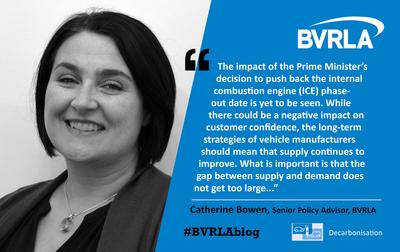Following the launch of the association’s 2023 Road to Zero Report Card, Catherine Bowen, Senior Policy Advisor at the BVRLA looks at the progress of Supply, from vehicle capabilities to aftermarket services and the pathway to net zero laid out in the ZEV mandate.

The model range and functionality of zero-emission vehicles (ZEV) available in the UK have continued to expand over the last year, bolstered by wider vehicle availability improving too. There is still room for improvement, notably for affordability and performance across all vehicle types.
The impact of the Prime Minister’s high-profile decision to push back the internal combustion engine (ICE) phase-out date is yet to be seen. While there could be a negative impact on customer confidence, the long-term strategies of vehicle manufacturers should mean that supply continues to improve. What is important is that the gap between supply and demand does not get too large, something already being threatened in the used market.
The company car sector has always been the first to adopt new vehicle technology. It is well on its way and will be fully ZEV ahead of official targets. Others face much harder transitions. Vehicle rental, the retail market, and commercial vehicles have a mountain to climb if they are to adopt zero-emission vehicles in the volumes required. Targeted financial support and incentives will play a vital role. The vehicles themselves are also proving to be a barrier, particularly for commercial vehicles. Concerns over range, carrying capacity and speed of recharge are yet to be widely overcome by the electric vans currently on the market.
Businesses planning their decarbonisation journeys need to be sure of their destination and deadline. The ZEV Mandate provides that steer and should ensure more zero-emission vehicles come to the UK. The mandate will be implemented from January 2024 and will require vehicle manufacturers to achieve a target as a percentage of their total annual sales that must be zero-emission. Manufacturers will be given annual sales allowances, they can bank these for use in future years or trade them with other firms, the idea is to help firms with low ZEV volumes in the early years of the scheme.
Looking at ZEV product suitability, there has been notable growth in the choice of ZEV car models, with the number of models quadrupling since 2018 to around 80 models in 2023. Just as fuel economy is important for ICE, energy efficiency is a crucial factor in determining the total cost of ownership and the range of an electric vehicle. The current distribution of models and sales indicates that the battery electric car market is focused on premium vehicles, with relatively few affordable models or sales below £30,000, in sharp contrast to many more ICE models in that price bracket. The upfront cost appears to remain the main barrier to mass electric car adoption, with a need for more affordable ‘urban’ commuter cars where range (and battery capacity) may be less important.
With 23 van models now available, the number of ZEV light commercial models is improving. There is still work to do, with a lack of fit for purpose product contributing to a recent slump in new electric van registrations. In June 2023, new electric van registrations comprised 5% of the market share, representing a 12% fall in registrations from June 2022.
From the wide list of factors, range is the overriding barrier. Only 18% of electric vans have a WLTP range greater than 200 miles. Fleet operators point out that real-world driving ranges are typically much lower than the quoted WLTP range due to factors such as heavier operational payloads and weather conditions. Zero-emission van models with a real-world range greater than 200 miles are extremely limited.
There are also risks of technician skills not keeping up with ZEV uptake in the future. By the end of March 2023, the number of qualified ZEV technicians reached 18% of total technicians. However, research by The Institute of the Motor Industry (IMI) has revealed a risk that technicians won't met continued demand to work on EVs due to aging workforce. Qualified technician availability is still inconsistent across the UK, presenting an underlying risk to decarbonisation plans and creating a postcode lottery for those with ZEVs.
As ZEV market penetration increases and more data becomes available, running costs will become better understood. Developing cost effective solutions for high-voltage battery repair, refurbishment, reuse, and recycling is crucial to minimise the impacts of battery maintenance on consumers and businesses.
None of the challenges facing vehicle supply are insurmountable. As with other parts of the transition, cars have led the way to date and have provided many learnings for other vehicle types to learn from. The van sector has always been a different proposition though and those learnings will only go so far. Van operators are crying out for tailored solutions and a wider range of vehicles. Both are required if supply is going to catch up with demand to help vans reach the heights seen by zero-emission cars.





